Contents
- Diet Principles #5
- Показания
- What can you eat on diet number 5?
- What can not be eaten on diet number 5?
- Table menu number 5 for the week
- Interesting recipes
- Table No. 5A
- Table №5B
- Table №5P (1)
- Table №5P (2)
- Chair No. 5 GA
- Table №5Sch
- Table No. 5G or 5L/F
- Table №5Р
- Table number 5 for children
- Pros and cons of table number 5
- Recommendations of dietitians
- Feedback and results
Diet 5 table is one of the specialized methods of therapeutic nutrition created by Dr. M. I. Pevzner. It is great for people who suffer from pathologies of the liver, gallbladder and biliary tract outside the acute stage.
This diet does not imply restrictions in kilocalories, but drastically reduces the presence of foods containing fats and “bad” cholesterol in the menu. But it is allowed to eat a lot of vegetables and sweet baked or boiled fruits. Under a categorical ban is such a method of cooking as frying in a pan or deep-fried.
Diet Principles #5
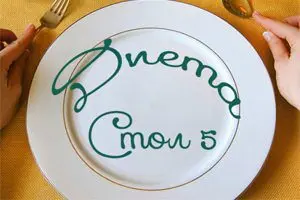
The goal of the diet is to reduce the burden on the liver and biliary system by introducing healthy food into the body.
Basic principles of diet number 5:
Sufficient content in the menu of carbohydrate and protein foods.
Cut back on foods containing fat.
Permitted methods of heat treatment of food are boiling and stewing. You can rarely bake dishes.
You should only wipe foods that contain a lot of fiber. If the meat is sinewy, then it should be chopped into small pieces.
Frying food is strictly prohibited.
Do not eat foods that contain purines and oxalic acid.
You can not include in the menu dishes that increase gas formation in the intestines. These are products containing coarse fiber, extractive substances that provoke the production of digestive juices.
The amount of salt in the diet should be limited.
You need to eat food at least 4-5 times a day. Portions should be small.
Be sure to drink water on an empty stomach.
Показания

Diet 5 table is a therapeutic diet, so it has certain indications:
Diseases of the liver, gallbladder, biliary tract without the stage of exacerbation.
Cirrhosis of the liver.
Cholelithiasis.
Surgical interventions for the removal of the gallbladder.
What can you eat on diet number 5?
The daily diet involves eating foods that meet a given calorie content and chemical composition:
No more than 100 g of proteins. Of these, half of the proteins should be of plant origin, and the other half of animal origin.
No more than 90 g of fat. Moreover, the share of vegetable fats should account for about 30%.
No more than 450 g of carbohydrates.
At least 1,5 liters of water, more is possible.
No more than 3000 kcal. To clarify the number of kilocalories, an individual calculation will be required.
No more than 10 g of salt.
In order for the liver to function in full, it is possible to take hepatoprotective drugs during the diet, for example, Essentiale forte or Karsila.
Foods that can be eaten during diet number 5:
Name | Allowed Products |
Beverages |
|
Soups (main meal) |
|
Porridge and cereals |
|
Pasta |
|
Meat and meat products, fish |
|
Bread |
|
Fermented milk products, milk and products based on it |
|
Vegetables |
|
Berries and fruits |
|
Oil |
|
Eggs |
|
refreshments |
|
Condiments and sauces |
|
Confection |
|
What can not be eaten on diet number 5?
Name | Prohibited Products |
Beverages |
|
Soups |
|
Cereals and cereals |
|
Pasta and macaroni |
|
Fatty meats, poultry, fish. |
|
Bread |
|
Dairy and sour-milk products |
|
Pickled vegetables and mushrooms |
|
Berries and fruits |
|
Eggs |
|
Oils and Fats |
|
refreshments |
|
Sauces and condiments |
|
Dessert |
|
The presented menu differs in that it is compiled by professionals, therefore it is as balanced as possible. The body will receive all the vitamins and minerals it needs, but without burdening diseased organs.
You should eat in small portions, boil soups well. If hard meat is used for cooking, then it must first be cut into small pieces.
Dishes should not be too hot or too cold, they should be served warm. In the evening, before a night’s rest, you can drink a glass of 1% fat kefir, or a rosehip broth. Herbal teas and medicinal mineral water are also allowed.
| First meal | Main meal | Snack | Last meal |
1 | Oatmeal porridge with dried fruits, weak tea with milk. Second breakfast: Vegetable or fruit juice 200 gr. | Vegetable soup, boiled chicken breast, dried fruit compote. | Rosehip broth, cookies. | Mashed potatoes, steamed fish cutlet, berry juice. |
2 | Steam omelette, weak tea with milk. Second breakfast: vegetable or fruit juice. | Vegetarian borscht, lean beef cabbage rolls, jelly. | Applesauce, oatmeal cookies. | Friable buckwheat porridge, vegetable salad, rosehip broth. |
3 | Rice casserole, weak tea with milk. Second breakfast: vegetable or fruit juice. | Vegetable soup with buckwheat, steam meatballs, compote. | Fresh yogurt. | Pilaf from boiled meat, boiled beets, weak tea with honey. |
4 | Oatmeal soup with milk, boiled egg, weak tea with milk. Second breakfast: vegetable or fruit juice. | Boiled turkey meat, mashed potatoes, boiled beets, peach juice. | Dried biscuit, low-fat kefir. | Boiled crumbly buckwheat, fresh carrot salad, weak tea with honey. |
5 | Milk noodle soup, tea with milk. Second breakfast: vegetable or fruit juice. | Potato soup, a piece of boiled fish, beets stewed in milk, jelly. | Fresh curdled milk or kefir. | Mashed potatoes, a piece of lean boiled meat, weak tea with honey or jam. |
6 | Rice milk porridge, boiled egg, weak tea with milk. Second breakfast: vegetable or fruit juice | Vegetarian soup, steamed chicken cutlet with stewed cabbage, rosehip broth. | Kissel, cookies. | Low-fat cottage cheese with yogurt or kefir. |
7 | Milk porridge from a mixture of cereals, weak tea with jam. Second breakfast: vegetable or fruit juice | Vegetable soup, noodles with poultry meat, apple compote. | Fresh yogurt. | Lazy dumplings with cottage cheese and sugar, weak tea with honey. |
Interesting recipes
The recipes of the fifth table can be used not only for those people who suffer from diseases of the liver or gallbladder, but also for those who want to diversify their menu with tasty and healthy dishes. There are many interesting ways to prepare food for breakfast, lunch and dinner, so even during a diet you can eat tasty and varied.
Vegetable soup with zucchini
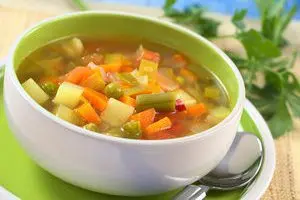
To prepare the soup, you will need the following food set:
Potatoes – 0,3 kg.
Zucchini – 150 g.
Carrot – 00
Vegetable oil – 3 Art. l
A liter of water and carrot juice.
Zucchini and carrots are peeled, cut into small slices and stewed in vegetable oil. Potatoes are cut into cubes and boiled, carrots and zucchini are added to it, salted and brought to a boil. Before serving, carrot juice is poured into the soup.
Mixed vegetable soup recipe
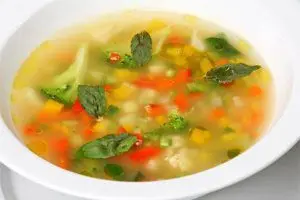
To prepare the dish, you will need the following food set:
Vegetable broth – 0,3 l.
Potato – 2 tubers.
Carrots – 1 pieces.
Zucchini – 30 g.
Vegetable oil – 2 tbsp. l.
Potatoes and zucchini are cut into cubes, carrots are grated and stewed. The tomato is also rubbed on a grater to make a gruel. The broth is brought to a boil, the vegetables are boiled in it until fully cooked. At the end of cooking, vegetable oil is poured into the soup. Boil for another 5 minutes.
Borscht
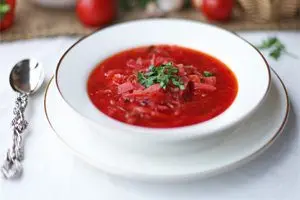
To prepare the dish, you will need the following set of products:
Fresh cabbage – 70 g.
Beets – 2 pcs.
Potatoes – 3 pcs.
Carrots – 2 pieces.
Vegetable oil – 3 tbsp. l.
Sour cream – 10
Sugar – 1 tsp.
Vegetable broth – 0,25 l.
Beets are rubbed on a grater, all other vegetables are cut into strips. Beets are stewed with carrots and added to the broth, which already contains potatoes and cabbage. At the end of cooking, sugar is added to the borscht. After a couple of minutes, the broth is turned off and allowed to brew. Before serving, add sour cream to the plate.
Steam omelet
Since fried eggs are forbidden to eat during the 5th table diet, they can be cooked in another way. A great solution is a steam omelette. In the first few days after the surgery, you can only eat egg white or quail eggs. When the early rehabilitation period is over, you can eat 1 yolk per day.
To prepare a steam omelet, you need to separate the yolk from the protein and beat the latter. Then salt and milk are added to the protein. The resulting mixture is laid out in a double boiler for 20 minutes. Before serving, you can decorate the dish with herbs.
Cabbage rolls with meat and rice
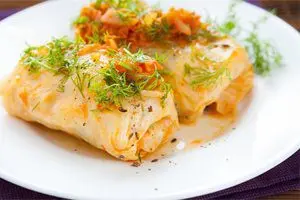
Stuffed cabbage is a dish that is allowed to be eaten while following the 5th table diet, but they must be cooked correctly.
You will need the following set of products:
Lean meat – 100 g.
Cabbage leaves – 130 g.
Rice – 15
Sour cream – 2 Art. l
Vegetable oil – 2 tbsp. l.
Greens – 30 g.
The meat is twisted in a meat grinder, cabbage leaves are boiled. Rice is poured with boiling water and infused for 20 minutes, after which the water is drained. The meat is combined with rice, vegetable oil and herbs. The resulting minced meat is spread on cabbage leaves and wrapped, giving the shape of envelopes. Spread the leaves in a cauldron, pour water and stew until tender.
Casserole with noodles and meat
The preparation of the dish will require the following products:
Beef 80 g.
Noodles – 80 g.
The protein of one chicken egg.
Butter 5
The noodles are boiled, the meat is boiled and cut into small cubes. Vegetable oil is added to the egg, mixed with minced meat, and then noodles are added to them. The casserole is steamed.
Curd pudding
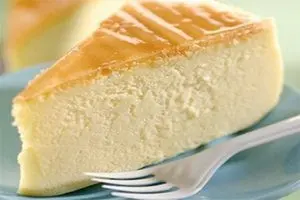
To prepare this delicious dessert, you will need the following products:
Cottage cheese – 120
Milk – 60
Butter – 5
Semolina – 10 g.
The white of one egg.
Sugar – 2 teaspoons.
Cottage cheese must be ground, then beat with a blender. Add protein and sugar to the curd mass, then put in a baking dish. The dish is either baked in the oven or cooked in a water bath.
Rice casserole
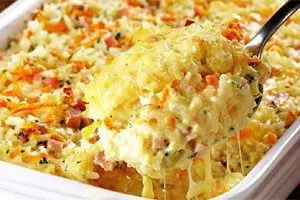
To prepare the casserole, you will need the following products:
Cottage cheese – 0,2 kg.
Rice – 1 glass.
Eggs – 3 pieces.
Apple – 3 pcs.
Raisins.
Milk – 2 glass.
Sugar – 2 st. l.
Sour cream – art. l.
Milk is mixed with water in equal proportions and rice is boiled in this liquid. The cottage cheese is ground, the eggs are beaten with sugar, the apples are cut into cubes.
Combine all components with each other, knead and spread in a baking dish. One egg is mixed with sour cream and a casserole is poured on top of it. The dish is put in the oven for 20 minutes (temperature – 200 ° C).
Berry jelly
Morse should be drunk warm. To prepare it, you will need various berries: cherries, raspberries, strawberries, blueberries, etc. For 2 liters of water, take 2 tbsp. l. starch, 4 tbsp. l. Sahara.
The berries are thoroughly washed before cooking, the bones are removed from them, poured with water and brought to a boil. Then, pre-diluted starch is added to the jelly and boiled until the drink becomes thick.
Slimy soup with oatmeal
To prepare the soup, the oatmeal must be washed well and boiled, then strained, but the cereal should not be washed. The strained broth is again brought to a boil and a little salt is added to it. The final product should not have grain particles, and in its consistency it resembles cream.
Cream soup with cauliflower, croutons and rice
To prepare mashed soup, you will need to boil the cauliflower and potatoes, pass them through a sieve, after separating several small inflorescences from the cabbage.
Rice is boiled for at least an hour, after which it is ground and combined with mashed potatoes and cabbage. The soup is poured with white sauce, butter, croutons are added to it and decorated with cabbage inflorescences. When the acute period of the disease has passed, vegetables can not be ground, but finely chopped.
Savoy cabbage soup
To prepare cabbage soup, you will need to finely chop potatoes, carrots. All vegetables, except potatoes, are stewed in water with a little oil.
Boil water separately, add potatoes and the resulting vegetable mixture to it, boil for a quarter of an hour. Savoy cabbage is added 5 minutes before the end of cooking. The soup is salted and brought to a boil. Before serving, you can put a few pieces of boiled lean meat on a plate.
Blue whiting with vegetables
Potatoes are boiled until half cooked, zucchini and carrots are cut. Lay out in a baking dish. Blue whiting fillet vegetables are covered on top. Bake in the oven until a crust appears on the fish.
Table No. 5A
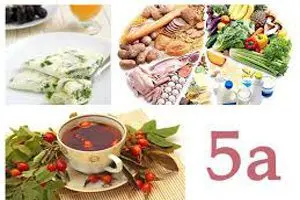
Indications:
Chronic pancreatitis
characteristics of the diet. The diet is balanced. It involves a moderate restriction of fats, restriction of salt, chemical and mechanical substances that irritate the mucous membrane of the gastrointestinal tract.
Exclude from the diet products that enhance fermentation and decay in the intestines, bile secretion. Therefore, products containing organic acids, extractives, essential oils in large quantities, cholesterol, purines are considered “harmful”. Fried foods are banned. Products that are excluded from the diet: rye and fresh wheat bread, first courses on meat, mushroom and fish broths; fatty meat and game, whole meat, offal, sausages, smoked products, canned food; salted, fatty, fried, stewed fish, caviar; fatty milk, cream, sour cream, fatty sour cottage cheese, spicy and salty cheese; cereals: millet, crumbly cereals, legumes; mushrooms, vegetables: turnip, cabbage, radish, radish, sorrel, onion, garlic; fruits and berries of sour varieties and rich in fiber; sweets: ice cream, chocolate, products with cream and whipped cream; spices and spices; drinks: black coffee, cocoa, carbonated and cold water.
Cooking methods are reduced to boiling or steaming. Sometimes you can include baked dishes on the menu, but they should not have a hard crust.
Products need to be wiped or finely chopped. Grains are thoroughly boiled. You should eat at least 5 times a day, eating small meals.
Chemical composition and energy value. The amount of fats, proteins and carbohydrates that are recommended to eat during the 5A diet:
Carbohydrates – 350-400 g
Proteins – 80-100 g
Fats – no more than 80 g, 20-25% vegetable (if dyspepsia has pronounced symptoms, then fats are limited to 5 g per day).
The maximum allowable number of kilocalories per day is 2350-2750 kcal.
| Breakfast number 1 | Breakfast number 2 | Main meal | Afternoon snack | Last meal |
1 | Protein omelet. Rice porridge mashed with diluted milk. Tea with lemon. | Curd casserole. | Vegetable soup. Braised carrots. Boiled meat in the form of a soufflé. Compote. | Bad cookie. Tea. | Vermicelli with cheese and butter. Still mineral water. Kefir before a night’s rest. |
2 | Meat cutlets with milk sauce. Salad of grated apples and carrots. Coffee with milk. | Steam fish of low-fat varieties. Braised beets. Soup puree potato. Kissel based on permitted berries. | Biscuit. Rosehip decoction. | Buckwheat casserole. Mineral water. A glass of yogurt before bed. | |
3 | Oatmeal with diluted milk. Cottage cheese with sour cream. Tea. | Baked apple. | Boiled ground rice. Boiled chicken. Soup with vegetables. Dried fruits compote. | The juice. | Mashed potatoes. Steamed fish cakes. Serve cutlets with milk sauce. Rosehip decoction. Kefir before a night’s rest. |
4 | Pasta with butter. Beef soufflé. Tea with milk. | Lazy dumplings with sour cream. | Vegetable soup. Chicken meatballs, mashed potatoes. Kissel. | 1 banana and 1 grated soft apple. | Cheese. Tea. Kefir before going to bed. |
5 | Buckwheat grated porridge with butter. Cottage cheese. Coffee with milk. | Baked apple. | Soup puree with potatoes and cauliflower. Vermicelli. Meat soufflé. Kissel. | Biscuit. Tea. | Mashed potatoes. Boiled fish. Salad of boiled vegetables. Mineral water. Kefir before a night’s rest. |
6 | Herculean porridge with diluted milk. Steamed meatballs. Tea. | Jam from apples. Carrot puree. | Soup on diluted milk with vermicelli. Curd pudding with sour cream. Compote. | Kissel. | Semolina. Still mineral water. Kefir. |
7 | Rice boiled grated. Steamed lean fish. Weak tea. | Baked apple. | Soup with cereals and vegetables. Vermicelli with a steam cutlet under milk dietary sauce. Compote. | Rosehip decoction. Cookies piscatel. | Cheesecakes with sour cream. Protein omelet. Mineral water. A glass of yogurt. |
Table №5B
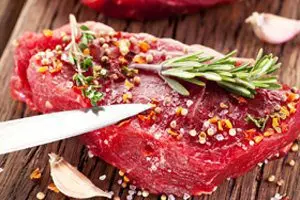
Diet table No. 5B is indicated for the following diseases:
Acute hepatitis.
Acute course of cholecystitis.
Cirrhosis of the liver against the background of moderate organ failure.
Gastritis, gastric ulcer against the background of cholecystitis and hepatitis.
characteristics of the diet. The diet of table No. 5B is not physiologically complete, it does not have enough nutrients and energy value to satisfy the daily human need.
It is based on the principles of Diet #5, but the carbs and fats are further reduced. Dishes are cooked exclusively on steam, without adding salt to them. All products are wiped.
You need to eat on a 5B diet every 3 hours, in small portions. This diet is implemented exclusively in hospitals and no longer than 6 days. Then the patient is prescribed a 5A diet.
Against the background of a 5B diet, vitamin C deficiency is possible, so the patient is required to prescribe a rosehip decoction.
The 5B diet involves the use of the following amounts of fats, proteins and carbohydrates per day:
No more than 80 g of protein, and 45 g of proteins must be of animal origin.
No more than 40 g of fat.
No more than 250 g of carbohydrates.
You can consume no more than 1600 kcal per day.
The amount of fluid consumed, regardless of food intake, is at least 2 liters.
Salt is completely removed from the menu.
Meals should have a temperature of 20 to 55 °C Celsius.
The menu for diet No. 5B may look like this:
Breakfast number 1: semolina porridge, egg white omelet, tea.
Breakfast number 2: vegetable soufflé, compote.
Main meal: soup with rice, low-fat meat soufflé, baked apple.
Snack: fruit jelly, tea with milk.
The last meal: fish meat soufflé, compote.
Before going to bed, you can drink a glass of jelly.
Table №5P (1)
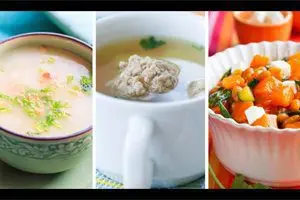
Diet table No. 5P is indicated for the following diseases:
Chronic course of pancreatitis, the stage of remission of the disease;
The need to normalize the work of the pancreas, gallbladder;
Restoration of the functions of the stomach, intestines, liver after illness.
characteristics of the diet. The main goal pursued by the diet is to reduce the pain caused by pancreatitis. The menu is designed in such a way that it relieves the burden on the gallbladder and pancreas, does not irritate the intestinal mucosa.
The diet is physiologically complete, it is slightly limited in fat content.
Dishes are steamed or boiled. Products must be ground and semi-liquid.
The patient should drink at least 6 times a day, in small portions. The diet is recommended after a forced therapeutic hunger strike.
The diet assumes the following daily set of fats, proteins and carbohydrates:
No more than 90 g of proteins, and 45 g of them must be of animal origin.
Not more than 80 g of fats, where 1/3 part is fats of vegetable origin.
No more than 350 g of carbohydrates per day.
Not less than 2100 kcal per day, and not more than 2500 kcal.
Water, regardless of food intake, you need to drink at least 1500 ml
Salt is limited to 10 g maximum.
Vitamin A (retinol) – 0,3 mg, beta-carotene 10 mg, Vitamin B2 (riboflavin) – 2 mg, Vitamin B1 (thiamine) – 1,3 mg, Vitamin B3 (PP, nicotinic acid) – 6 mg, vitamin C (ascorbic acid) – 150 mg.
Trace elements: iron – 30 mg.
Macroelements: calcium – 0,8 g, sodium – 3 g, magnesium – 0,5 g, phosphorus – 1,3 g.
Temperature range of dishes: 20-50 °C Celsius.
The menu for one day might look like this:
Breakfast number 1: steamed protein omelette, viscous and pureed oatmeal in water, tea.
Breakfast number 2: fruit jelly and tea.
Main meal: slimy rice soup with vegetable broth, chicken dumplings, berry soufflé.
Snack: steamed cottage cheese soufflé, rosehip broth.
Last meal: fish soufflé, vegetable puree, compote.
Before going to bed, a rosehip broth and crackers.
Table №5P (2)

Indications for use. This diet is recommended for patients who suffer from acute pancreatitis in the stage of extinction, or when the exacerbation is not too pronounced. Perhaps its appointment to patients with chronic inflammation of the pancreas.
characteristics of the diet. The main purpose of the diet is to prevent recurrence of the disease. It is also aimed at bringing the metabolism back to normal.
During the diet, a person should consume an increased amount of protein foods, but somewhat limit fast carbohydrates and salt.
You can not include in the menu products containing extractive substances, and dishes rich in coarse fiber.
The main method of heat treatment is steam. Also, products can be boiled, stewed and baked. If there is such a need, then the dishes should be wiped.
Food is consumed at least 5 times a day, in small portions.
Stick to table 5P (2) for 8-12 weeks. If the patient begins to feel worse, then this table is canceled and returned to the one that preceded it.
The daily energy value and chemical composition of products while following diet No. 5P (2) is as follows:
The amount of proteins should not exceed 120 g, and half of them should be of animal origin.
The amount of carbohydrates should not exceed 90 g, and 1/3 of the part falls on vegetable fats.
The amount of carbohydrates is not more than 350, and simple carbohydrates per day should not be consumed more than 40 g of this amount.
Water should be drunk at least 1,5 liters per day.
Salt restriction – no more than 8 g per day.
Vitamins: vitamin A – 0,4 mg, beta-carotene – 13 mg, vitamin B2 – 2,6 mg, vitamin B1 – 1,3 mg, vitamin B3 – 17 mg, vitamin C – 250 mg.
Macroelements: sodium – 4 g, calcium – 1,3 g, magnesium – 0,5 g, phosphorus – 1,9 g.
Trace elements: iron – 35 g.
The temperature of the dishes should be 15-60 °C Celsius.
When compiling the menu, you can focus on the following diet:
Breakfast number 1: steamed cottage cheese pudding, milk porridge, tea.
Breakfast number 2: boiled tongue, tea and crackers.
Lunch: soup with rice on vegetable broth, beef stroganoff, vegetable puree, compote.
Snack: soufflé from allowed fish, jelly.
The last meal: cottage cheese, chicken dumplings, rosehip broth.
Before going to bed, you can drink kefir.
Chair No. 5 GA
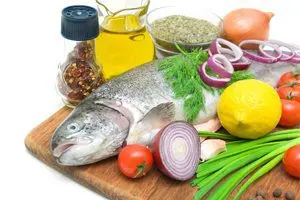
Indications for use. Table No. 5GA is based on the menu of the dietary table No. 5. However, there are some differences.
For example, items such as:
Processed cheese;
Eggs;
Fish and seafood;
Ice cream;
Bulgarian pepper;
Sauerkraut and all pickles;
Hazelnuts and peanuts;
Seeds and sesame;
Citrus;
Strawberries, raspberry grapes;
Peaches, apricots, pomegranates;
They stuck;
Melon;
Kiwi;
Semolina, millet;
Milk;
Fruit drinks containing chemical additives;
Chocolate, cake, pastille, marshmallow.
Such prohibitions are explained by the fact that the diet is hypoallergenic.
characteristics of the diet. A hypoallergenic diet allows you to remove toxins from the body, which will help reduce allergy symptoms. A person begins to feel much better, starting from the first days of the transition to table No. 5GA. You can achieve maximum results when working with an allergist.
The daily chemical composition and energy value of the menu should look like this:
Proteins: no more than 90 g per day, with 45 g of protein should be animal-based.
No more than 80 g of fat per day, where 1/3 part is vegetable fats.
No more than 350 g of carbohydrate food, where only 40 g is allocated to simple carbohydrates.
The maximum amount of fluid per day is 2 liters, but not less than 1,5 liters.
It is allowed to consume no more than 10 g of salt per day.
Vitamins: vitamin A – 0,5 mg, beta-carotene – 10 mg, vitamin B2 – 4 mg, vitamin B1 – 4 mg, vitamin B3 – 20 mg, vitamin C – 200 mg.
Iron – 15 mg.
Sodium – 4 g, calcium – 1,2 g, potassium – 4,5 g, magnesium – 0,5 g, phosphorus – 1,6 g.
The temperature of the dishes during their serving to the table should vary between 15 and 60 °C.
| First meal | Main meal | Last meal |
1 | Oatmeal porridge, tea, sweet baked fruit | Soup with cabbage, boiled chicken, apple jelly. | Porridge with rice, steamed cutlet, low-fat kefir. |
2 | Bread with cheese, yogurt, tea. | Soup with vegetables, compote with dried fruits. | Boiled potato tubers, beef tenderloin goulash, pear. |
3 | Porridge, apple, tea. | Soup with vegetables and meat, compote. | Boiled fish, apple, tea. |
4 | Biscuit biscuits, mashed sweet apple (or banana) salad, yogurt. | Borscht without meat, steamed cutlet, compote. | Buckwheat with lean meat, stewed vegetables, tea. |
5 | Millet porridge, tea. | Vegetable soup with beef, mashed sweet apple salad (or 1 banana), kefir. | Rice with goulash, jelly. |
6 | Bread with chicken, 1 banana, tea. | Soup from a mixture of cereals, banana, compote. | Pasta with cabbage and greens salad, kefir. |
7 | Cottage cheese casserole, tea. | Soup with vegetables, steamed cutlet, dried fruit compote. | Buckwheat porridge, cutlet, pear, yogurt. |
Table №5Sch
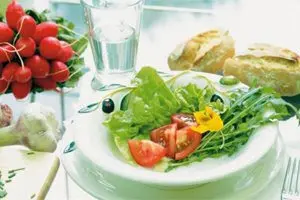
Indications for use. This diet allows you to maximally facilitate the work of the organs of the digestive system, reduce the amount of bile separated. Therefore, it is prescribed for exacerbation of chronic gastritis, with postcholecystectomy syndrome, accompanied by duodenitis.
characteristics of the diet. The diet is aimed at reducing bile production. Therefore, the menu is designed in such a way as to relieve the load from all digestive organs, and especially from the liver. Patients adhering to this diet will be able to normalize lipid metabolism, reduce weight.
However, the No. 5Sch diet cannot be called complete, as it imposes a restriction on fats and carbohydrates. In addition, the daily caloric content will be reduced, but moderately.
The menu should not include products containing extractives, coarse fiber, vegetable fats.
The main method of heat treatment is steaming and boiling. Prepared dishes are wiped.
Once a week they spend a fasting day.
There should be at least 5 approaches to the table per day, and portions should not be voluminous.
The daily chemical composition and energy value of table No. 5Sch is as follows:
Fats – no more than 60 g.
Proteins – no more than 90 g.
Carbohydrates – no more than 300 g.
You can not exceed the norm of 2200 kcal per day.
Water should drink at least 1,5 liters.
The maximum amount of salt is 6 g.
Vitamins: vitamin A – 0,3 mg, beta-carotene – 7 mg, vitamin C – 100 mg, vitamin B2 – 1,5 mg, vitamin B1 – 1 mg, vitamin B13 – XNUMX mg.
When compiling the menu, you can focus on the following option:
Breakfast number 1: curd pudding with fruit-based gravy, meat soufflé, compote.
Breakfast number 2: fruit mousse, rosehip broth.
Main meal: soup with vegetables and pureed oatmeal, cutlets with fish fillet, mashed potatoes and juice.
Afternoon snack: cracker and jelly.
The last meal: boiled chicken, squash stewed with sour cream, juice.
Before going to bed: rosehip decoction.
Table No. 5G or 5L/F
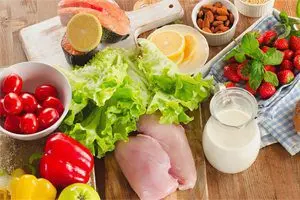
Indications for use. The diet allows you to normalize the intestinal circulation of bile and enhance the process of its separation. Therefore, diet No. 5G is indicated for patients with stagnation of bile in the liver and gallbladder, people with hypotension of the gallbladder, and patients after removal of this organ.
characteristics of the diet. The main goal pursued by the 5G diet is to normalize the circulation of bile in the body. With its help, it is possible to normalize fat metabolism.
This diet is physically complete, it contains a normal amount of proteins and carbohydrates. Moreover, the proportion of fats is even slightly increased.
The menu should include products that contain high-quality proteins and polyunsaturated fatty acids.
Frying is strictly prohibited, dishes can be boiled, baked, steamed. There is no need to wipe the products.
You should eat at least 5 times a day, in small portions.
The daily energy value and chemical composition of the diet No. 5Zh is as follows:
No more than 90 g of proteins.
Not more than 120 g of fats, and vegetable fats in this mass should be 50 g.
No more than 350 g of carbohydrates, of which simple carbohydrates should not exceed 40 g.
Caloric content per day should not be more than 3100 kcal.
You need to drink at least 1,5 liters of water per day.
The maximum amount of salt consumed per day is 6 g.
Vitamins: vitamin A – 0,3 mg, beta-carotene – 10 mg, vitamin B1 – 1,7 mg, vitamin B2 – 2,5 mg, vitamin B3 – 19 mg, vitamin C – 200 mg.
Sodium – 3,5 g, calcium – 4,5 g, potassium – 4,5 g, magnesium – 0,5 g, phosphorus – 1,6 g.
Iron – 40 years.
The temperature of the dishes should vary between 15 and 65 °C Celsius.
When compiling the menu, you can focus on the following option:
Breakfast number 1: semolina porridge with butter, boiled soft-boiled egg, coffee.
Breakfast number 2: tea and berries.
Main meal: rice cereal soup, vegetable salad with vegetable oil dressing, juice.
Afternoon snack: rosehip broth and cottage cheese.
Last meal: boiled meat, pumpkin soufflé, tea.
The day can be completed with a glass of kefir.
Table №5Р
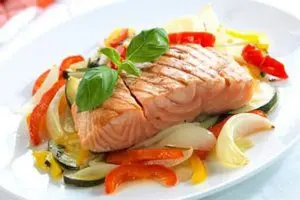
Indications for use. This diet is prescribed for dumping syndrome, after gastric resection and against the background of peptic ulcer.
characteristics of the diet. The diet is intended for patients who have undergone surgery on the stomach. It allows you to recover faster by reducing the production of gastric juice, which means that the intestines and stomach will not be subjected to chemical and mechanical irritation.
The diet is physiologically complete. In this case, the patient eats an increased amount of protein foods, but is limited in carbohydrate foods. Moreover, simple carbohydrates are removed from the menu altogether, and complex carbohydrates are minimized.
Dishes can be boiled, steamed. Food is not eaten too hot or too cold.
You need to eat at least 7 times a day, but in small portions. At a time, you should drink no more than 200 ml of liquid, half an hour after eating. Do not drink water while eating.
The daily energy value of the diet and the chemical composition of the dishes are distributed as follows:
No more than 120 g of protein per day.
No more than 90 g of fat per day.
No more than 400 g of carbohydrates per day. Moreover, simple carbohydrates should be 20-30 g.
The maximum daily calorie content is 2800 kcal.
Liquids should be drunk 1500 ml
The maximum amount of table salt is 8 g.
Meals should be served within the temperature range of 20-55°C.
There are three menu options for the 5P diet:
All dishes are washed.
Meat products are chopped, and side dishes can be left viscous.
Dishes are not wiped. This option is possible when the patient feels well for a long time.
A sample menu for a non-wiped option for home use might look like this:
Breakfast number 1: boiled meat, grated fresh carrots with olive oil dressing, tea.
Breakfast number 2: buckwheat porridge, rosehip broth.
Breakfast number 3: steamed meat cutlets, fresh sweet apple.
Main meal: boiled meat, minestrone soup, compote.
Snack: cottage cheese and fruit jelly.
Last meal: steamed egg white omelette, boiled fish.
Before going to bed, you need to drink a glass of kefir and eat a few crackers.
Table number 5 for children
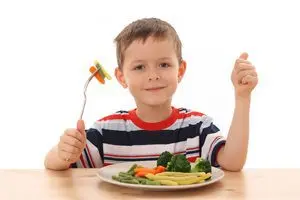
Children more often than adults suffer from disorders in the functioning of the biliary system, but inflammation of the gallbladder and bile ducts is much less common in them. However, even such seemingly minor problems can provoke serious malfunctions in the liver and pancreas. Therefore, the kids are also assigned table number 5.
The children’s dietary scheme is not much different from the adult menu. Dishes are also boiled and steamed. The more often food enters the digestive tract, the better the biliary system works. Therefore, meals should be frequent, but in small portions. It is good if the child has a diet that should not be abandoned.
It is important that the menu meets the needs of the child’s body, depending on its age. For example, five-year-olds should be given proteins that are easy to digest. First of all, we are talking about milk, fish, eggs, but subject to the absence of an allergic reaction. Fat is limited in case of dysfunction of the sphincters against the background of an increase in their tone (up to 0,5 g per kg of weight). The emphasis should be on vegetable fats, and refractory fats should be removed from the menu. If a child has hypomotor dyskinesia, then the daily intake of vegetable fats is increased to 1,2 g per kg of weight.
Sample menu for a child on diet number 5:
First meal | Omelet with steamed milk, buckwheat porridge with vegetable oil, tea with milk. |
Breakfast number 2 | Rice pudding, baked apple. |
Main meal | Soup with vegetables and sour cream. Chicken soufflé. Mashed potatoes. Fruit juice. |
Snack | Cheese casserole. Pumpkin juice. |
Last meal | Fish with milk sauce. Oatmeal. Rosehip infusion. |
Before bedtime | A glass of yogurt. |
Pros and cons of table number 5
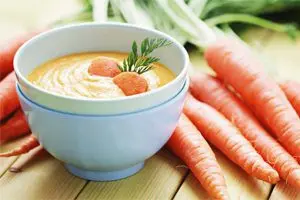
Diet Benefits:
The diet is balanced, restrictions are easy to endure.
Allows you to regulate the work of the liver and gallbladder.
It is an excellent prevention of recurrence of the disease.
Cons of the diet:
Some dishes require a complex and lengthy cooking process.
The diet will have to be followed for a long time.
Recommendations of dietitians

Diet 5 table is designed not to restore diseased organs, but to eliminate those causes that provoke an exacerbation of the disease. It will help speed up the healing process.
You can’t make your own diet. It must be recommended by a doctor. During the diet, the patient needs to take medications in parallel.
Bread should only be eaten dry. Fresh pastries from the menu should be eliminated.
It is impossible to lose weight with this diet, it is prescribed for diseases of the liver and gallbladder, and not for obesity.
With the help of a diet, you can quickly recover, remove excess fluid from the body, eliminate joint pain.
Therapeutic nutrition is an important component of the treatment of diseases of the digestive system, so you should endure restrictions on the menu for the sake of your own health.
Feedback and results

Patients often call the 5 table diet the liver diet, as it is designed to solve problems in the functioning of this organ. Reviews about this power system are only positive. It allows you to get rid of many troubles: eliminate constipation and belching, reduce gas formation in the intestines, eliminate heaviness and pain in the right side. The only drawback of the diet, patients call that some dishes take too long to cook.
“I am always prescribed this diet when I go to the hospital with an exacerbation of cholecystitis. Then for 3 months I stick to it at home. During this time, the condition improves significantly: the taste of bitterness in the mouth disappears, belching disappears, and it becomes very easy in the stomach. I can’t stick to this diet for longer, because it’s too difficult to cook for myself separately, and for the family separately. It takes a lot of time”
“Table number 5 is my permanent diet after my gallbladder was cut out. I feel good, the extra weight is gone. I deviate from the diet very rarely, basically, I follow all the rules. This allows you to stay healthy. But it’s quite problematic to cook only for yourself.”
“I have cholecystitis and pancreatitis. Therefore, the doctor prescribes me the same diet, but with a high protein content. When a bitter taste appears in my mouth, I begin to strictly monitor my diet. When it gets better, I gradually remove the restrictions. I cook food for a couple, all my household members are happy to eat with me.









